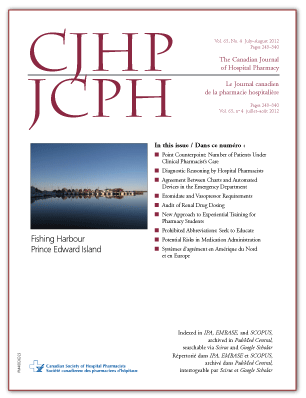Does Etomidate Increase Vasopressor Requirements in Patients Needing Mechanical Ventilation?
DOI:
https://doi.org/10.4212/cjhp.v65i4.1157Keywords:
etomidate, adrenal insufficiency, vasopressors, critical care, mechanical ventilation, étomidate, insuffisance surrénalienne, vasopresseurs, soins intensifs, ventilation artificielleAbstract
ABSTRACT
Background: Single-dose etomidate is used as an induction agent for rapid-sequence intubation and is associated with transient adrenal insufficiency. There is ongoing debate as to the clinical consequences of this transient adrenal insufficiency for critically ill patients.
Objective: To determine if the use of etomidate is associated with higher requirements for a vasopressor, relative to other induction agents, at a single time point (24 h after administration of the induction agent) in patients needing mechanical ventilation.
Methods: In this retrospective observational study utilizing electronic health records, a convenience sample of 50 patients who had undergone intubation in the emergency department with etomidate were matched (1:1) with patients who had received other induction agents. Matching was based on primary admitting diagnosis relating to the cause of shock, APACHE II (Acute Physiology and Chronic Health Evaluation II) score, age, and sex. All patients were subsequently admitted to critical care areas for management. As a surrogate marker of hemodynamic instability, the vasopressor dose was recorded 24 h after intubation. Vasopressor doses were converted to norepinephrine equivalents for comparison.
Results: The mean dose of vasopressors, in norepinephrine equivalents, was 4 μg/min-1 for patients receiving etomidate and 3 μg/min-1 for the control group (mean difference 0.7 μg min-1, 95% confidence interval [CI] –1.9 to 3.2 μg min-1, p = 0.61). Twelve of the patients in the etomidate group and 16 of those in the control group required the use of vasopressors at 24 h following intubation (odds ratio 2.3, 95% CI 0.53 to 13.99, p = 0.34).
Conclusions: Single-dose etomidate does not adversely affect hemodynamic stability, as measured by the dose of vasopressors required at 24 h after administration.
RÉSUMÉ
Contexte : L’étomidate administré en dose unique est utilisé comme agent d’induction pour l’intubation en sequence rapide et est associé à une insuffisance surrénalienne transitoire. Il existe toujours une controverse quant aux conséquences cliniques de cette insuffisance surrénalienne transitoire chez les malades en phase critique.
Objectif : Déterminer si l’utilisation d’étomidate est associée à des besoins accrus en vasopresseurs, par rapport à d’autres agents d’induction, à un moment unique (24 heures après l’administration de l’agent d’induction) chez les patients ayant besoin de ventilation artificielle.
Méthodes : Dans le cadre de cette étude d’observation retrospective réalisée à partir de dossiers médicaux électroniques, un échantillon de commodité de 50 patients ayant subi une intubation dans le service des urgences au moyen d’étomidate ont été appariés (1:1) avec des patients qui avaient reçu d’autres agents d’induction. L’appariement était fondé sur le diagnostic principal à l’admission relatif à la cause du choc, l’indice APACHE II (Acute Physiology and Chronic Health Evaluation II), l’âge et le sexe. Tous les patients ont été par la suite admis à des unités de soins intensifs pour être pris en charge. On a consigné la dose de vasopresseurs administrée 24 heures après l’intubation comme critère de substitution de l’instabilité hémodynamique. Les doses de vasopresseurs ont été converties en équivalents-norépinéphrine à des fins de comparaison.
Résultats : La dose moyenne de vasopresseurs, en équivalentsnorépinephrine, était de 4 μg/minute chez les patients recevant de l’étomidate et de 3 μg/minute chez les patients du groupe témoin (différence moyenne de 0,7 μg/minute, intervalle de confiance [IC] à 95 %: –1,9 à 3,2 μg/minute, p = 0,61). Douze des patients du groupe étomidate et 16 du groupe témoin ont eu besoin de vasopresseurs 24 heures après l’intubation (risque relatif approché de 2,3, IC à 95 % : 0,53 à 13,99, p = 0,34).
Conclusions : L’administration d’une dose unique d’étomidate n’affecte pas la stabilité hémodynamique, d’après les mesures des doses de vasopresseurs requises 24 heures après l’administration de l’étomidate.
Downloads
Published
Issue
Section
License
Copyright © Canadian Society of Healthcare-Systems Pharmacy.
After publication of a manuscript in the CJHP, the authors of the manuscript must obtain written permission from the CSHP (publications@cshp.ca) before reproducing any text, figures, tables, or illustrations from the work in future works of their own. If a submitted manuscript is declined for publication in the CJHP, all said rights shall revert to the authors. Please note that any forms (e.g., preprinted orders and patient intake forms) used by a specific hospital or other health care facility and included as illustrative material with a manuscript are exempt from this copyright transfer. The CJHP will require a letter from the hospital or health care facility granting permission to publish the document(s).










